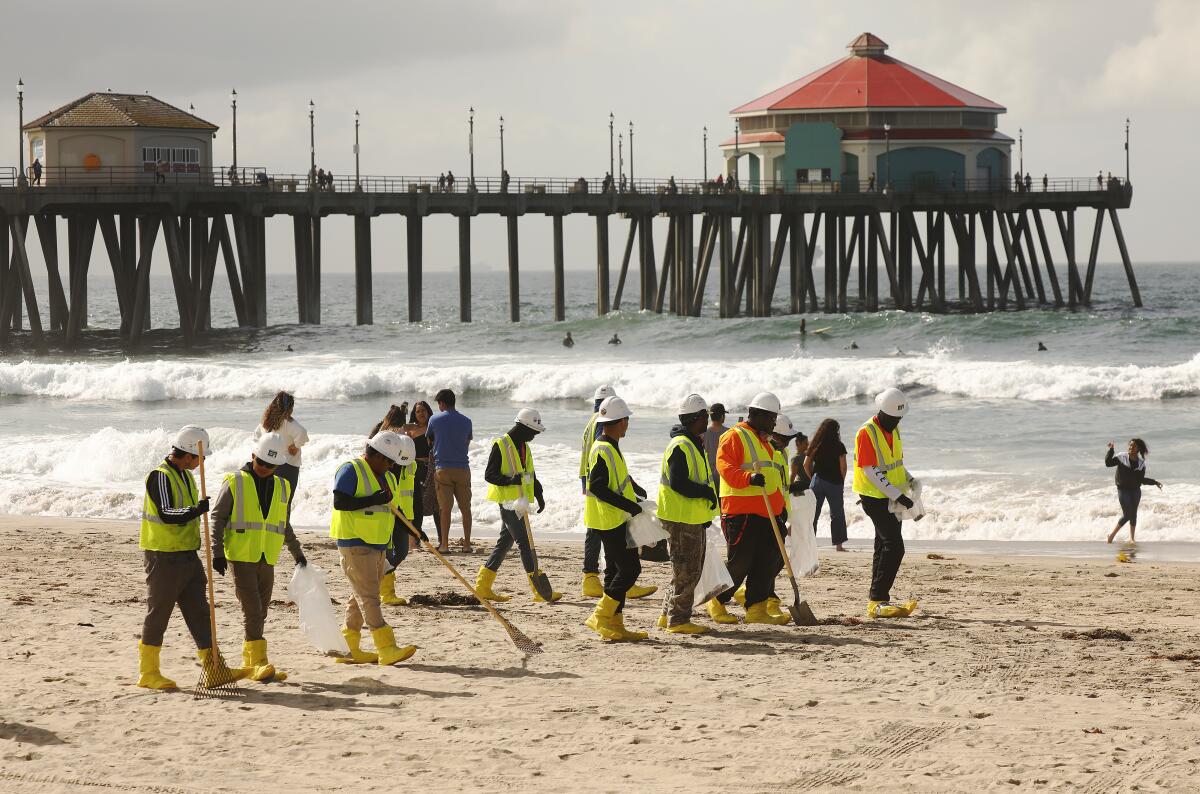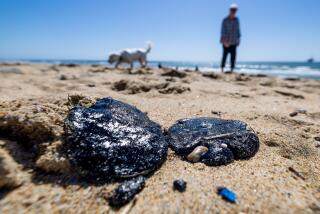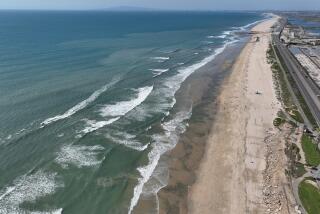The O.C. oil spill could have been a much bigger disaster. Here is what went right

- Share via
As oil began washing up on the shores of Huntington Beach early Sunday, officials were preparing for a worst-case scenario.
Tens of thousands of gallons of oil had gushed into the ocean from a broken pipeline connected to an offshore platform, just miles from shore. Crude had already entered the ecologically sensitive Talbert Marsh area, and officials feared more wetlands and the life inside them were at risk.
They still were not sure whether the source of the leak had been plugged.
Over the next few days, crashing waves churned up dead fish and oil covered birds struggled to take flight. Large plumes of oil menaced the coast from Huntington Beach to San Clemente. But a combination of luck, favorable weather conditions and aggressive response from officials who had learned from previous oil spills resulted in a less severe crisis than was originally feared.
It will still take months to assess the long-term effects and to determine exactly how much oil spilled. The estimates range from 24,696 gallons to 131,000. Yet officials know it could have been a lot worse.
“We really dodged a bullet,” Huntington Beach Mayor Kim Carr said. “When you hear that thousands of gallons of oil has been released and is quickly approaching your shores you can’t help but think the worst.”
The biggest break Orange County got was the one officials could not control: ocean currents. That pushed the plumes of oil south without large amounts breaking onto the shores. Beaches as far south as San Diego County were hit by tar balls but escaped large inundations of oil. That was in marked contrast to the much larger 1990 American Trader oil spill, which left beaches, jetties and wetlands covered in crude. That spill ended up fouling 15 miles of beach in Orange County.
Also spared in the recent spill were some of the picturesque, rocky coves along the coast south of Newport Beach, which officials initially feared could be hit.
“The winds and where the spill was located was really in our favor,” Laguna Beach Mayor Pro Tem Sue Kempf said. “Even though we don’t have a lot of evidence of negative effects on the marine protected areas, there’s a lot we don’t know, so we have to remain vigilant for a while.”
Vessels working along the coast have benefited from light winds that have enabled them to deploy more than 11,400 feet of booms to help contain the spill and prevent it from washing into sensitive marine habitats. Pollution-control vessels have skimmed more than 5,500 gallons of oil from ocean waters. An army of 1,600 workers and volunteers had removed 250,000 pounds of oily debris from the shoreline by Monday.
Experts say wind, waves and tides can all steer an oil slick, which is a thin layer that sits on the surface of the ocean.
The slick, which has crept south several miles offshore of San Clemente, is also affected by the churning ocean. That action helps to break up more concentrated parts of the spill and send a small portion to the ocean floor. The movement of the ocean also helps some of the oil dissolve and pushes some oil to the surface, where its affected by the wind and currents.
Mild conditions have kept the bulk of the oil offshore, which is much simpler for crews to clean than crude that has made its way onto the coast, said Matthew Bracken, a professor of ecology and evolutionary biology at UC Irvine.
“We’re seeing tar balls and some patches on shore, but none of the real devastating effects that we have seen in past spills that we’re really afraid of,” Bracken said. “Once it hits the beaches, gets into the sand and the gravel and into the cracks and crevices in the rock, it’s a whole different situation. In that case a lot of the cleanup efforts are at least as immediately damaging to the animals and plants that live there as the oil itself.”
John Villa, executive director of the Huntington Beach Wetlands Conservancy, watched in horror last weekend as an oily sheen seeped into Talbert Marsh, a 25-acre ecological reserve considered to be a critical link along the migratory bird route called the Pacific Flyway.
His mind raced with questions: “Where’s it going to go? How bad is it going to be?”
On Saturday afternoon, even as Coast Guard officials said an oil incursion likely wouldn’t happen before Monday, Huntington Beach officials decided to deploy booms to protect their wetlands. They installed the protective barriers at the Talbert Inlet Channel, the Warner Bridge off Pacific Coast Highway and the Warner Fire Station to protect the Bolsa Chica Wetlands, a nearly 1,500 acre swath that remains the largest saltwater marsh between Monterey Bay and the Tijuana River Estuary. Officials also placed roughly 1,000 feet of protective boom across the entrance to Talbert Marsh.
The Bolsa Chica Wetlands have remained unscathed. Though some oil did seep into Talbert Marsh, Villa credits the fast response of city officials with keeping larger slicks from entering and destroying the sensitive habitats inside.
“Every time that high tide came in, it would be carrying more contaminated oil,” Villa said. “It was devastating.”
He called Orange County Public Works a day after officials learned of the spill and asked them to block the entrance of the Talbert channel, the conduit by which oily ocean water was entering the marsh. Workers quickly erected a sandy berm — 10 feet tall and higher than the king tide — at the entrance of the inlet.
Villa said it was 10 years after the American Trader oil spill of 1990 that the Talbert Marsh began to rebound. Pickleweed and cordgrass, which provided habitats for two endangered birds, the Belding‘s savannah sparrow and the Ridgway’s rail, died from the contaminants. This time, he said, officials were faster to react.
“I’m relieved that we were able to stop the flow as fast as we did, because if it wasn’t for that I think we would have had a lot more contaminants in the marshes,” he said.
Huntington Beach’s oil spill response plan, which was developed several years ago, outlined the tools they would need in the event of a large intrusion, but officials didn’t have the supplies on hand until earlier this year. Fire Chief Scott Haberle, who took over the department in 2020, saw gaps in the plan and applied for grants to get the gear they needed. It was fortuitous timing, Carr said.
“He has been very forward thinking and has made sure we’re prepared for this on all levels,” she said.
Much about the cause of the spill remains unknown. Questions also remain about what actions were taken by Amplify Energy Corp., the pipeline operator’s parent company, once it realized oil was leaking. Coast Guard investigators said that damage to the nearly 18-mile oil pipeline, which runs from the Port of Long Beach to an offshore oil platform known as Elly, could have occurred several months to nearly a year before the spill.
Investigators suspect an initial anchor strike displaced a portion of the pipeline 105 feet and stripped away its concrete casing, causing it to be more vulnerable to other potential anchor strikes or environmental stressors, U.S. Coast Guard Capt. Jason Neubauer said last week. Coast Guard investigators plan to bring in experts to determine how long ago the pipe was damaged and when it began leaking.
As officials await answers, Huntington Beach and Newport Beach once again welcomed swimmers and surfers Monday. Water quality testing showed no toxins associated with the spill , officials said.
Surfers paddled out to catch waves. Children wet their ankles at the shoreline. A man wearing headphones sat on a red towel at the shore to draw. The only lingering signs of the spill were yellow-vested cleaning crews carrying rakes to scoop up tar balls and oil-soaked kelp from the sand.
Surfer Monica Dunn, 36, emerged from the water elated, after crude oil and caution tape kept her away from the water for more than a week.
“The waves are not good, but it feels good to be in the water,” she said. “I feel alive.”
More to Read
Sign up for Essential California
The most important California stories and recommendations in your inbox every morning.
You may occasionally receive promotional content from the Los Angeles Times.












